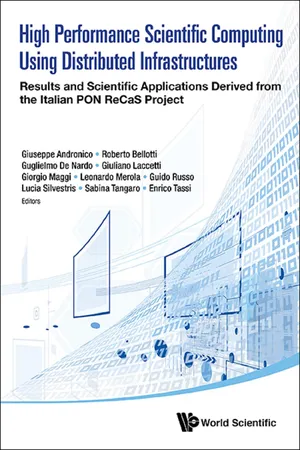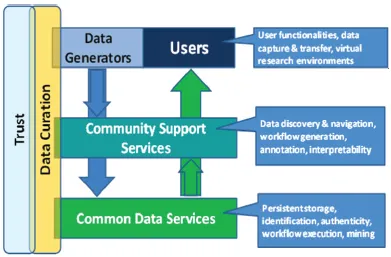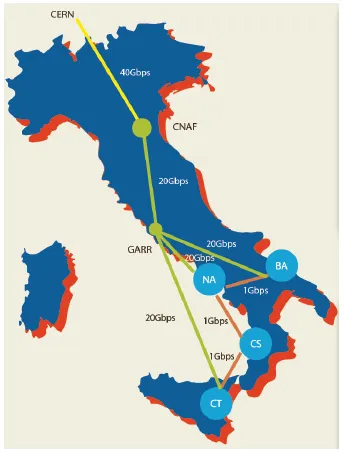![]()
Chapter 1
The ReCaS Project
L. Merola
Università Federico II, Napoli, Italy
Istituto Nazionale Fisica Nucleare, Napoli, Italy
[email protected] This paper gives a general description of the Rete di Calcolo per SuperB e altre (ReCaS) project and of the infrastructure which has been realized in four data centers in Southern Italy, namely Napoli, Bari, Catania, and Cosenza, thanks to the Italian National Operational Programme for “Research and Competitiveness” 2007–2013 (PON for R&C) administered by the Italian Ministry of University and Research. At present, the ReCaS data centers are fully operational and integrated in the national and international Grid/ Cloud infrastructure.
1.Introduction
Started in October 2011 and completed in summer 2015, the ReCaS project1 was funded by the Italian Ministry of Research and Education (MIUR) through the program National Operational Programme for “Research and Competitiveness” (PON for R&C) 2007–2013 Call 254 Action I “support for structural changes and scientific & technological improvement for a transition towards a knowledge economy” for the development and enhancement of a distributed computing infrastructure of Grid/Cloud type over the four EU “Convergence” regions in Southern Italy: Campania, Puglia, Sicily, and Calabria.
The acronym stands for “Rete di Calcolo per SuperB e altre applicazioni ” (Computing network for SuperB and other applications, ReCaS).2 The SuperB was a Istituto Nazionale Fisica Nucleare (INFN) project for a new accelerator in the Rome area that has been cancelled by the Italian government due to budget limitations. Now ReCaS is a computing network infrastructure in Southern Italy devoted to scientific and non-scientific applications within the vision of a common European infrastructure for computing, storage, and network.
The actuators are the University of Naples Federico II, the University of Bari Aldo Moro and the National Institute of Nuclear Physics (INFN) with its sections in Naples, Bari, Catania, and Cosenza. In the two sites of Catania and Cosenza, there are fundamental operational synergies respectively with the University of Catania and the University of Calabria.
A lot of experience in the context of previous PON 2000–2006 program, INFN and UE grid projects, has been fully exploited, e.g., SCoPE project in Naples, PI2S2 in Catania.
The program is integrated in the 2007–2013 European Union strategy and takes benefit from the partnership between MIUR and MiSE which is the Italian Ministry for the Economic Development (Fig. 1). It is based on total investment of 13.7 million euros, respectively 6.9 M to INFN, 2.1 ME to University of Naples Federico II (UniNA), 4.7 ME to UniBA. The objective is to transform these regions into drivers of social and economic development.
Fig. 1. Partners and funding agencies.
The ReCaS project and infrastructure are managed by an Executive Committee chaired by L. Merola with representatives of the three institutions (INFN, UniNA, and UniBA).
2.The Objectives
The main objective of the project is a better integration of the various initiatives already present in Southern Italy, carried out by research and academic institutions, including INFN and Universities. The collaboration between INFN and University in scientific and technological research and development dates back to early ‘50 of the last century and has been crucial for the present project. High throughput computing (HTC) and high performance computing (HPC), big data preservation in the medium and long term, need a national infrastructure federated between the various actors in Italy in order to be internationally competitive and integrated in a European Grid/Cloud infrastructure.
The network will be open and accessible to all researchers, public and private, and will be characterized by unprecedented — in the academic context — computing power and storage capacity. Posted in the European Grid Infrastructure (EGI), ReCaS is also an opportunity to the countries of the Mediterranean area and extends the potential of the current network, composed of four major supercomputing infrastructure made by the PON 2000–2006. Thanks to numerous technological spin-offs of the territory, ReCaS fully responds to the need to promote the competitiveness of enterprises in Southern Italy.
The main scientific users for the development of the ReCaS infrastructure are the 4 major international collaborations (ALICE, ATLAS, CMS, LHCb) of the CERN Large Hadron Collider (LHC). In all four ReCaS sites, there are scientific communities who actively participate in the above experimentation.
Furthermore, the ReCaS computing and storage resources are also available to any interested public and private researchers coming from different scientific domains and applications, e.g., from the Science and Technology of Materials, Science and Technology of Aerospace, Mathematics and Computer Science, the Chemistry, Science of Life, Cultural Heritage, and so on (Fig. 2).
Fig. 2. Scientific and industrial users.
The ReCaS infrastructure is also supporting a number of projects and collaborations both of national and international interest as PRISMA-Smartcities, BioVeL, ELIXIR-ITA, KM3NeT, LCGWLCG, Belle2 experiment (Japan).
It also aims at promoting collaborations with scientific and academic institutions in the Mediterranean area; recently an agreement has been signed with Egyptian universities.
ReCaS provides services based on open standards that allow interoperability between datacenters and data-based architectures which can implement all the elements of the model platform for the processing of big data and that has been recently defined by the European Commission for Horizon 2020 (Fig. 3).
Users can choose from an exhaustive set of application software (Fig. 4).
The project also included a training activity through the establishment of university post degree masters, in Naples and in Bari, followed by summer schools on Cloud Computing and Science Gateways and stages for the best students at the four ReCaS sites.
Fig. 3. Horizon 2020 model for big data processing.
Fig. 4. Application software.
3.The Infrastructure
The four data centers are connected to each other through a high bandwidth network (Fig. 5) which is foreseen to be upgraded with links at 40/100 Gbps in the near future. They are also connected to the rest of the Italian GARR research and academic network and through it to CERN and to international links not shown in the figure.
Fig. 5. The ReCaS network.
Fig. 6. The Naples data center. Computing resources: 132 servers, 4,956 cores. Storage capacity: 4,957 TB.
All the four data centers (Figs. 6, 7, 8 and 9) have realized HPC infrastructures which are used both by local users and by the ReCaS and the national/ international community. The details of each configuration will be described elsewhere in this review volume.
Fig. 7. The Bari data center. Computing resources: 128 servers, 8,192 cores, HPC cluster with 20 GPU nodes for a total of additional 800 cores. Storage capacity: 3,552 TB on disk and 2,500 TB on tape (tape library).
Fig. 8. The Catania data center. Computing resources: 54 servers, 2,562 cores. Storage capacity: 324 TB.
Fig. 9. The Cosenza data center. Computing resources: 90 servers, 3,500 cores. Storage capacity: 900 TB.
4.The Training Program
By the training program associated to the project, a total of 50 experts were formed, with two different profiles: (a) experts in the field of data analysis, with particular reference to the applications and the use of HPC for physics res...









